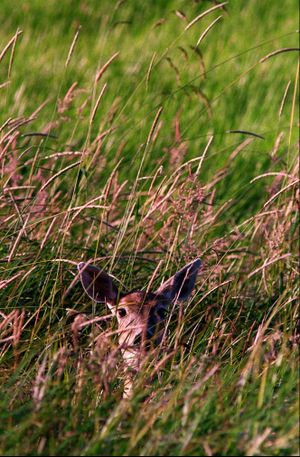Columbian white-tailed deer recovery celebrated
ENDANGERED SPECIES -- Hailed as a conservation success story by wildlife officials, the Columbian white-tailed deer has been downlisted to threatened after being federally classified as endangered for nearly 40 years.
The new status for the coastal subspecies of whitetails is being announced today at a ceremony in Ridgefield, Washington.
Here are more details from the Vancouver Columbian:
The Columbian are the only variety of white-tailed deer west of the Cascade mountain range. The species was first listed as endangered in the mid-1960s, with only 450 remaining in Washington and Oregon. Today, wildlife officials estimate there are more than 900 of the deer in three locations in Washington and Oregon.
The downlisting “shows these lands have a critical role in wildlife recovery,” said Christopher Lapp, manager of the Ridgefield National Wildlife Refuge Complex.
To be clear, the Columbian white-tails are not off the endangered species list, but reclassifying the species as threatened gives landowners, states and tribes more flexibility in how to manage and move the deer populations. The U.S. Fish & Wildlife Service says such flexibility can lead to greater populations and distribution through their natural range.
Roughly 125 of the deer live at the Ridgefield National Wildlife Refuge, but they don’t always stay within its boundaries. Lapp said 2015 population estimates say 12 of the deer live on nearby private land, and between 15 and 20 of them live on Sauvie Island.
The Ridgefield refuge was originally created to manage for dusky Canada geese, but it’s also proved to be very suitable habitat for the deer, Lapp said.
The event’s keynote speaker is Michael Bean, principal deputy assistant secretary for fish and wildlife and parks at the U.S. Department of the Interior.
In a prepared statement, Bean praised local officials and the work they’ve done to encourage the deer’s recovery.
“The Pacific Northwest has been a real leader in working to protect and recover species through collaborative conservation,” he said. “The Columbian white-tailed deer is a great example of what it takes to recover an endangered animal. Without the work of the Cowlitz Indian Tribe, the states of Washington and Oregon, and many other partners and volunteers, these deer would not be trending toward a bright future.”
In 2013, wildlife officials began a three-year program that relocated about 90 deer to the Ridgefield refuge from the Julia Butler Hansen Refuge near Cathlamet and nearby Puget Island in the Columbia River.
The deer is part of the “Class of 1967,” the first group of animals to receive federal protection under the Endangered Species Protection Act. The list also included 14 mammals, 36 birds, more than 20 varieties of fish and six types of reptiles and amphibians -- the California condor, bald eagle, and grizzly bear among them.
Re-establishing the deer’s population has taken years of work and collaboration between the Cowlitz Indian Tribe, Washington and Oregon wildlife agencies, conservation groups, volunteers and the Fish & Wildlife Service. Scientists tagged and tracked the deer, and occasionally employees of the U.S. Department of Agriculture’s Wildlife Services culled coyotes on the refuge to protect them.
There are two populations of Columbian white-tailed deer. The Lower Columbia River population is found in Washington’s Wahkiakum, Cowlitz and Clark counties, and Oregon’s Clatsop and Columbia counties.
The other subpopulation, in the Umpqua River Basin of Oregon, was removed from the endangered species list in 2003.

